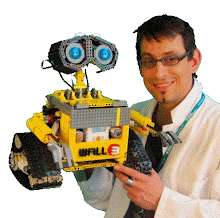Big NXT project made in Canada inspired by one of The NXT Step contributor's project dating back in the RCX time...
The Lego NXT Pinball machine, built by Mark Gryn of the School of Computer Science, University of Windsor and Michael, an 11th grade student who is participating in a co-op program at the University of Windsor is pretty impressive creation. It uses 6 NXT's, 9 touch sensors, 10 light sensors and 4 motors along with over 8000 LEGO bricks!
Read the full story here, where you can download instructions, NXT-G program and learn among other things that, (and I quote) "The inspiration for this Lego NXT Pinball machine came from a machine built by Gerrit Bronsveld & Martijn Boogaarts. Their machine was built back in 2005 using the old version of the Lego robots known as RCX."
If you want to know more on the project that inspired this LEGO Mindstorms pinball machine be sure to review the article on PinballNews.com
The Lego NXT Pinball machine, built by Mark Gryn of the School of Computer Science, University of Windsor and Michael, an 11th grade student who is participating in a co-op program at the University of Windsor is pretty impressive creation. It uses 6 NXT's, 9 touch sensors, 10 light sensors and 4 motors along with over 8000 LEGO bricks!
Read the full story here, where you can download instructions, NXT-G program and learn among other things that, (and I quote) "The inspiration for this Lego NXT Pinball machine came from a machine built by Gerrit Bronsveld & Martijn Boogaarts. Their machine was built back in 2005 using the old version of the Lego robots known as RCX."
If you want to know more on the project that inspired this LEGO Mindstorms pinball machine be sure to review the article on PinballNews.com
